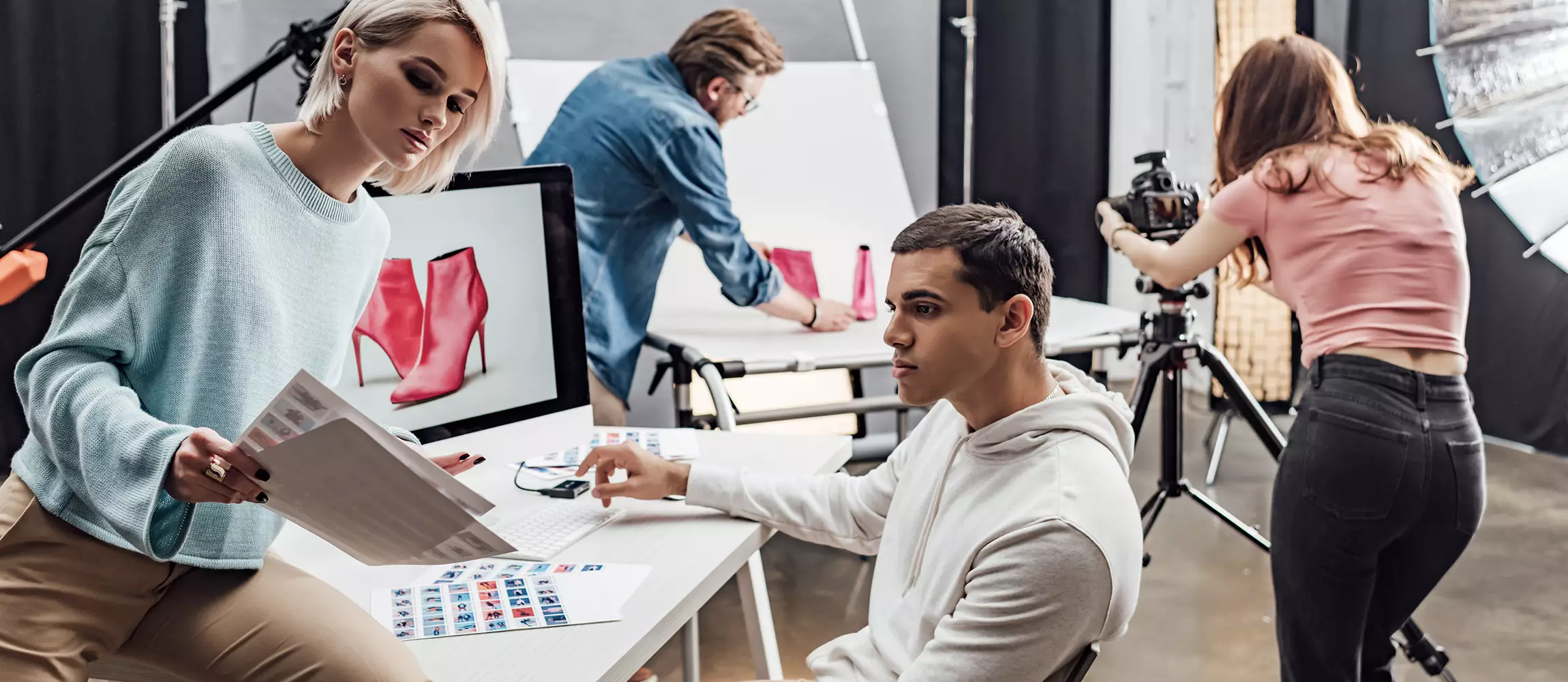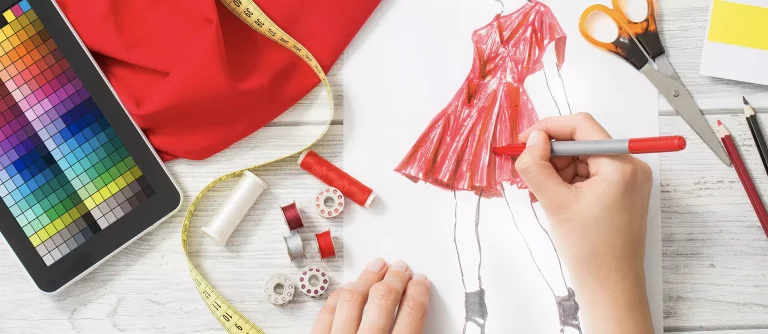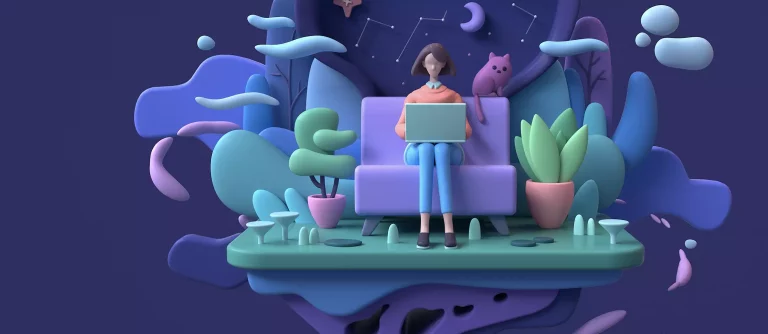How To Become an Art Director
Many people working in the creative industry have ambitions of becoming an art director. This is a demanding, high-pressure job that requires unique personality traits.
An art director is responsible for a team of people who work together to create a finished product. There are multiple industries where art directors work. You have to be well organized, good with people and delegating tasks, know how to review, edit, request changes, and assemble the final submission project. In some cases, you may be responsible for other duties.
In this article, we’re going to look at how to become an art director. We’ll discuss the role and responsibilities, the education and work experience requirements, and how to find the right job.
What is an Art Director?
Art directors are in charge of a team of artists. It’s your job as an art director to take the creative director’s ideas and turn them into a pleasing aesthetic layout.
Once you’ve planned everything, you also have to relay these ideas to your group and divide the staff’s tasks. You also have to provide the descriptions for the various components of the layout.
Directors are responsible for the entire project, including production, editing, and execution. You have to delegate, organize, lead, and be creative if you want to succeed as an art director.
In smaller companies, there may not be a creative director that plans the project. Instead, there may only be an art director, who will have to do all the creative director’s tasks, plus the role of an art director.
What Does a Typical Workday for an Art Director Look Like?
Art directors have a busy schedule every workday. You can expect to spend a lot of time reviewing materials submitted by your staff. You have to edit, approve, and compile all of this material into your final design or presentation.
Art directors also have to keep up with and stay on budget for multiple projects. You’ll have to work out schedules and timelines for your team each week. You also mediate between various departments to meet the client’s instructions. You may work with production, copywriter, and artist supervisors.
You can expect to have daily or weekly meetings with your team. And you may also have to meet with your creative director to come up with design layouts. If there isn’t a creative director, it may be your responsibility to make all the plans.
An art director will be responsible for defining the content:
- Font type and size
- Graphics
- Video
- Sound
- Animation
- Graphics
- Layout
Will I Like Being an Art Director?
When you do what you love, it doesn’t feel like work. Working as an art director can be a rewarding and exciting experience for some people. But it’s a high-demand job that requires leadership and organization. Let’s look at some characteristics and skills of a good art director.
Characteristics and Skills of a Good Art Director
If you want to be an art director, it helps to have these crucial skills, which you’ll use every day while fulfilling an art director’s responsibilities.
Creativity
Having a creative mind is one of the best characteristics of an art director. You have to be able to design appealing layouts and come up with ideas that flow.
You also have to keep up with current trends and predict what might be coming into the season. As an art director, you can use your creative mind to be innovative and think outside the box.
Many art directors have an artistic background and have some drawing abilities. But if you’re not an artist, it doesn’t rule you out as an art director. Some get by using computer software and a talented team.
Organization
As an art director, you are responsible for the final design of each project. This job requires you to be able to organize multiple products and team members.
You have to be able to plan, execute, and delegate the different parts of your project. All content goes through you for edits and approval.
If you have a fly-by-the-seat personality that doesn’t understand how to stay organized and on task while juggling multiple projects, you may struggle with an art director’s role.
Leadership
An art director role requires you to know how to delegate tasks to your team members. You have to know how to keep your staff inspired and working together.
While you are a leader, you also have to be a team player. When your staff works together in sync, things go smoother. You meet deadlines, and your content has a better flow. An efficient team knows how to blend their styles to match the client’s needs.
Time Management
You will need excellent time management skills if you want to be a successful art director. This is a time-consuming role that requires you to keep up with multiple responsibilities daily.
Many directors put in more than forty hours per week. You have to know how to prioritize your time to get all of your tasks done each day.
You also have to know how to respond under pressure and stress. There’s rarely any downtime when you work in the role of an art director.
Why You Might Not Like Being an Art Director
The position of art director won’t appeal to everyone. If you don’t do well in a high-power job where you have to make quick decisions, manage others, and take on many different tasks, you may become overwhelmed and unhappy.
And if you can’t handle working under pressure and deadlines, you may struggle with an art director’s role. The same goes if you lack people skills. You have to be able to communicate your ideas and needs to your team.
If you’re shy or uncomfortable talking to groups of people, you may find the numerous meetings unwelcome stress. People who struggle with being authoritative may find discomfort at having to control a team of people.
Typical Schooling for a Successful Art Director
Most companies that employ art directors require a minimum of a bachelor’s degree – either a BA or a Bachelor’s of Fine Art, which can take four years to obtain. If being an art director is your career goal, you’ll want to consider a field of study in:
- Art
- Graphic design
- Web design
- Animation
- Advertising
- Fashion designer
- Fine arts
- Game design
- Marketing and communications
- Journalism
- Public relations
While obtaining your four year Bachelor’s degree, there are some classes you can take that would give you an advantage in an art director career. Ideal courses that you can take include:
- Web design
- Photography
- Typography
- Digital media
- Computer graphics
- Color theory
- Interactive graphics
- Printmaking
Some candidates continue their education to obtain a master’s degree in Fine Arts. Most companies won’t reject an applicant if they do not have an advanced degree. But it may give you an advantage over less educated candidates.
However, if your competition has more work experience, some companies may prefer job skills over higher education.
Becoming an art director requires work experience, in addition to your Bachelor’s degree. Most people will not be able to start in this role right out of college. This is a competitive position that many candidates desire. It can take five years of experience before you’re qualified for an art director role.
If you plan to move into the role of art director, you should start in a position in the same industry and work your way up the ranks. Typical entry-level jobs that many art directors start in include:
- Copy editors
- Photography
- Advertising
- Marketing
- Graphic designers
- Artists
- Illustrators
While gaining work experience, you should also start putting together your portfolio. Regularly update your resume to keep track of your developing skills.
Art directors work in multiple industries, including advertising and public relations, publishing, and movie production. Pick your industry and find a starting position.
Working your way up the chain of command helps you build better leadership skills because you know your staff’s pressures. You’ll have the first-hand experience that allows you to make adjustments in the way things are done so your team is more productive and unified.
Best Art Director Colleges
You can get a four-year bachelor’s degree at any college in the country. The top three best art director colleges to attend are schools that encourage you to think outside the box and learn to be innovative in your thinking process.
UCLA Design Media Arts
The UCLA Design Media Arts college is a great school to attend if you’re serious about becoming an art director. The programs offered center around helping you think outside the box and tap into your creative side.
There are undergraduate and graduate programs at this university, so you can complete your entire higher education at the same alma mater. There are multiple fields of study and electives to teach you the skills you’ll need in your career.
Tuition at this school is $35,134 a year for California residents. For non-California residents, tuition will cost $30,204.
The University of Illinois at Chicago School of Art and Design
The School of Art and Design, hosted by the University of Illinois, offers a Bachelor of Design, a BA of Design, and Master of Design programs so you can obtain all the education you need.
While attending The School of Design, you can study graphic or industrial design. Students get hands-on experience from trained instructors. And they will graduate with a degree and a broad creative portfolio to present to potential employers.
Tuition for The University of Illinois at Chicago School of Art and Design goes by semester. It varies depending on if you’re an Illinois resident or an out-of-state student. For Illinois residents, tuition is $27748 a year, while it will cost $55,132 for out-of-state students.
University of Cincinnati College of Design, Architecture, Art, and Planning
The University of Cincinnati College of DAAP (Design, Architecture, Art, and Planning) is an excellent school for aspiring art directors. Regardless of which field of study you decide to pursue, you’re sure to get a top-notch education and full college experience.
You can obtain your Bachelor’s in Planning, Art, Design, or Architecture. Or continue your education further to get your Master’s in the same study.
Tuition is calculated by per-credit-hour and by your area of study. A semester for Illinois residents can cost around $23,200 a year, while out-of-state residents may owe $53,988.
Best Art Director Online Colleges
Some people choose to skip the in-person schooling process and want to attend college online. We’ve found the three best online colleges for obtaining a degree to prepare you for being an art director.
Savannah College of Art and Design
The Savannah College of Art and Design has four physical campuses – two in Georgia (Savannah and Atlanta), one in Lacoste, France, and the final in Hong Kong. However, it also has an outstanding art online program for Bachelor’s and Master’s degrees.
You can enroll in eLearning for degrees in interior design, animation, advertising, illustration, design management, advertising, and arts leadership. They have advanced Master’s programs to further your education.
Because the Savannah College of Art and Design is such a renowned and highly awarded school, it has a tuition of $38,075 a year.
Southern New Hampshire University
Another great online art college to attend for art directors is the Southern New Hampshire University. This school offers more than 200 programs, including art and design.
You can build up skills you’ll need for your career while getting in touch with your artistic side. Instructors are industry experts that help you build a portfolio in game design, graphic design, or web design.
Yearly online tuition for attending the Southern New Hampshire University is $9,600. This sum is based on 30 credits at $320 per credit hour.
Full Sail University
The final best online college you can attend to get a degree as an art director is Full Sail University. There are various degrees to choose from, including computer animation, digital arts, design, web design, advertising, web content, and other study fields.
The ideal thing about choosing Full Sail University is that you can obtain your Bachelor’s in 29 months, which is much faster than attending a four-year college in person.
Tuition for Full Sail University is fixed throughout your enrollment, so you don’t have to worry about paying more as you get closer to graduating. The cost varies by cost per credit hour and length of completion. Most art degrees will cost $696 a credit hour, and it requires 120 credits to get your degree.
Can I Skip College and Teach Myself How to Be an Art Director?
Most companies that are looking to hire an art director will require at least a Bachelor’s degree. But there are times when other factors can help you move to the front of the candidate line without a degree. Focusing on these three alternative paths to become an art director.
Work Experience
When comparing potential candidates, employers pay close attention to work history and experience. If you want to be an art director, you can outshine the competition by padding your resume with positions related to your industry of choice.
When you keep your options open for new employment options, you are gaining different experiences that will help you fulfill the many responsibilities of an art director.
Be willing to start at the bottom and work your way up the ladder. Many times, if you work for a company that promotes from within, you stand a higher chance of getting higher-level jobs without a formal education.
As you grow your work experience, keep your resume filled out with any new skills, clients, or jobs you’ve handled. Keep track of the responsibilities you took during these jobs. And use your previous projects to build up an eclectic portfolio to present to future employers.
Freelance
Some people decide to become a freelance art director instead of working for one company. Many companies want to hire freelance art directors, which means you can have multiple clients.
To become a freelance art director, you will need to have an excellent portfolio that demonstrates your creative abilities, an impressive resume, and the necessary qualifications.
Many people transition into a freelance art director position after working in other roles for established companies. Having references or work experience from big names can help influence new clients into choosing your name out of the hat.
Internships
Another way to start your path to becoming an art director is to start as an intern. Some companies offer internships, which can help you learn your way around the business hierarchy.
Studies show that companies look favorably on art directors with internship experience in art, graphic design, advertising, film production, or other similar paths.
The downside of internships is that they are usually temporary positions lasting ten to twelve weeks. Some internships will not be a paid position, while others might offer a source of income. In rare cases, the internship can turn into a permanent entry-level position.
Which Software Programs Do Art Directors Use?
Art directors have to use multiple software programs in their day to day tasks. Getting experience with these eight pieces of software will make you better equipped for an art director’s role.
Photoshop
The most critical piece of software you can have in your arsenal is Photoshop. Many other software programs integrate with Photoshop, so it’s a well-used tool you’ll frequently use.
Photoshop will be a program that all your creative team members will use to create, edit, and form your presentations and projects. As an art director, you’ll need to review and make changes to your team’s work.
For graphic designers, you may prefer to learn Photoshop CC instead of CS6. Photographers would want to work with Photoshop Lightroom.
Adobe Creative Cloud
Adobe Creative Cloud is a group of apps for mobile and desktop devices. You can access programs for video editing, web, graphic design, UX, and photography.
Programs available from Creative Cloud are:
- InDesign – print and digital layouts
- Illustrator – art and illustrations
- Photoshop – photo editing software
- Premiere Pro – film and video editing software
- Adobe Fonts – Thousands of fonts
Becoming proficient in Creative Cloud and it’s many features and apps will help you in your role as art director. Having access to different apps in the same Cloud allows for easier collaboration and organization among your team.
Poser Pro
Poser Pro 12 is an excellent tool for creating and experimenting with 3D animation. This program provides the tools needed to make your projects animated.
Many people like to use this tool for animation without dealing with all of the various tasks needed to make an image three-dimensional. This software can streamline the process.
Poser can make graphics for education, games, medical, illustrations, art, comics, print, and web animations. For art directors who work with video games, animation, or other 3D material, you may find Poser a useful tool to learn.
AutoDesk SketchBook
SketchBook is an excellent piece of software for creating illustrations and paintings. This tool is helpful for architects, artists, and designers.
You can download Sketchbook to any device to access various drawing utensils, including markers, ink, pencils, and 190 custom brushes for texture and shapes.
You can use a stylus or your finger to draw. And a useful feature is that you can scan your hand drawings and transfer them into a digital image you can edit. It’s a great way to share doodles with your team and work with edits.
Unity Pro 4
Unity Pro 4 is the best tool to use for creating and testing games designed for PC, console, mobile, or Virtual Reality if you work in the video game industry.
Unity is an excellent tool for all areas of video game design, including designers, artists, scripters, and programmers. You can get your game from start to finish in a short amount of time, allowing for quicker production and release.
As an art director, you can use Unity to keep up with your team’s progress and test your game development. You can also see how well the game works during testing to figure out areas of improvement.
What Are the Best Blogs and Influencer Accounts to Follow?
A great way to keep up with your industry’s current trends is to find a few high-quality blogs to follow. If you’re a fan of social media, you may also want to follow some popular influencers.
One of the best blogs to follow for web designers is Webdesigner Depot. This blog provides daily posts related to web design, including developing trends, tutorials, essential tools of the craft, and reviews. You can also join the 273.5k Facebook and 675.2k Twitter fans.
The 99U blog is another useful site for art directors. This blog provides tips to help you improve your leadership, productivity, and organization skills. You can also follow 99U’s social media profiles, with 87.7k Facebook fans, 50.6k Instagram followers, and 208.3k Twitter fans.
5 Ways to Break into the Art Director Industry
Here are five ways to break into the art director industry. Following these tips can help increase your chances of being selected for an art director role.
Get Online
Create a portfolio website about you with your work.
If you want to be taken seriously as an art director, you want to have an impressive portfolio to present to prospective clients or employers. The easiest way to show your portfolio or a sample of your work is to design a website.
Three of the best website builders for creating a portfolio are WordPress, Squarespace, and Wix. When choosing between the different builders, it helps to pick a site that meets your needs.
Get Social
Social media can be for more than watching adorable animal videos and sharing memes. You can use the various social media channels to network with colleagues, find new jobs and clients, learn useful tips, and market your skills.
Anyone aspiring to be an art director should create professional profiles on popular social media sites, including Instagram, Facebook, Linked In, and Twitter. LinkedIn is the most important site to join for professionals. You can share your work experience, link with past, current and potential employers.
Become an Apprentice
If you are starting on your journey to becoming an art director, you may be starting at the bottom. Use this time to become an apprentice or intern for candidates who work in your industry.
When you work with someone who does the job you’re dreaming of, you get a bird’s eye view of the role’s ups and downs. You get to learn as you go, figuring out ways to become more efficient.
Continue Learning
Find paid tutorials or free YouTube videos that further your goal. Art directors should always be open to continuing to learn new things. Trends can happen overnight, and you have to be willing to change things up. You may have to learn new techniques or products.
Watching videos on YouTube is an excellent way to learn new skills and trends. You can learn about how to use products or keep up to date with new updates. You can also take classes, paid tutorials, or research sites like Reddit and Quora.
Keep Grinding
Don’t let early failures set you back. Being an art director typically requires a Bachelor’s degree and at least five years of industry-related work experience. So it’s not a position you’re going to be able to enter as soon as you join the workforce.
It may take longer than five years before you have the qualifications and history to add to your resume to impress larger companies. But you may be able to find a small startup that will take a chance on a lesser experienced art director. Keep going, and don’t give up.
FAQ
Here are a few frequently asked questions people have about becoming an art director. Learning the answers to these questions can give you a better idea of whether this would be a career you’d like to pursue.
How much money Do Art Directors typically make?
An art director’s salary can vary based on the company’s size, the company’s location, and your qualifications. You can expect to make between $67,930 to $126,5000, with $92,780 being the median salary.
California offers the highest salaries, particularly in large cities like Los Angeles and San Francisco. New York, New York, and Atlanta, Georgia are the other two highest paying locations for art directors.
What do you study to be an Art Director?
The great thing about an art director’s role is that it’s not limited to one field of study. Several different education paths work for an art director position.
Some of the most popular fields of study are advertising, film, graphic design, web design, communications, and marketing. You may also want to take classes to help develop your leadership skills.
Is Art Director a good career choice?
If you have the right characteristics and interests, becoming an art director is an excellent career choice. For you to enjoy the role of an art director, you have to handle pressure and deadlines, manage a team and multiple projects, and be a creative thinker.
Are there a lot of job openings for an Art Director?
You can come up against a lot of competition when it comes to open art director positions. There are usually many candidates trying to get the same position, especially in areas where there are limited jobs.
Competition may be less stiff in big cities where there are multiple open spots. Or in small areas where there are fewer potential candidates. However, recent reports suggest that there will be a 2% decline in art director positions over the next ten years.
What’s the best website to find Art Director job listings?
There are many sites where you can find job listings for the role of Art Director. Some of the most popular job sites are Indeed, GlassDoor, and Zip Recruiter. AIGA is the largest job board for designers, with some big-name clients. Authentic Jobs is another job listing site for creatives.
What are some big companies that hire Art Directors?
Art directors are often in multiple industries, and many big-name companies frequently look to hire art directors. Current listings for this position include offers from brands such as Apple, Amazon, HP, AT&T, Fox Sports, and ESPN.







